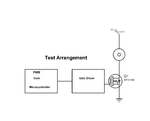dexter0904
Junior Member level 3
- Joined
- Mar 21, 2011
- Messages
- 25
- Helped
- 2
- Reputation
- 4
- Reaction score
- 2
- Trophy points
- 1,283
- Location
- Never Land
- Activity points
- 1,444
Any Suggestion ?
Regards,
Waqas
Regards,
Waqas
Follow along with the video below to see how to install our site as a web app on your home screen.
Note: This feature may not be available in some browsers.
Well That is obvious...I don't think a single opamp can provide enough current for fast switching.
dexter0904 said:a suggestion for 100 KHz MOSFET gate drive with op-amp
alexan_e said:an opamp can't provide enough current
dexter0904 said:Well That is obvious...

 Well, those comments are pretty help full...
Well, those comments are pretty help full...Correct, there op some amps which can tolerate heavy capacitive loads. For effective gate driving, you also need high output current and slew rate. For example the lm8272 in that article has a max output current of 65mA, which is very low for gate drive applications. Simple and inexpensive gate drive ICs have peak current ratings of several amps.There are some op-amps that are capable of driving un-limted capacitive load
**broken link removed**
If for some reason you need more elaborate control of the gate voltage, then maybe an op amp would have some advantage.
Nop, Its just switching...If for some reason you need more elaborate control of the gate voltage, then maybe an op amp would have some advantage.
greatMaybe that specific circuit is limited to 20KHz, but gate drivers in general are not. I've used some gate drive ICs in excess 200KHz at high power (like 500W), and 2.5MHz at lower power levels (around 50W).
ok, Blast Op-AmpBut I'm going to insist the op amp idea isn't going to work, or at the very least it would require extremely specialized components, and it still wouldn't work better than a logic gate driver.
If you want help designing a discrete driver, then I'll be glad to help.